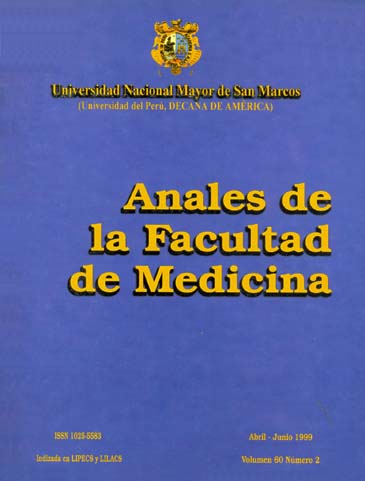Resistance Rates of Plasmodium Falciparum in Querecotillo, Sullana. January - July 1998
DOI:
https://doi.org/10.15381/anales.v60i2.4491Keywords:
Plasmodium falciparum, Chloroquine, MalariaAbstract
BACKGROUND: Resistance rates of Plasmodium falciparum in Querecotillo, Sullana, reported by the cohort study for the first semester of 1998, were greater than 50%. OBJECTIVES: To determine the types of Plasmodium falciparum antimicrobial resistance in this district. METHODS: A descriptive, retrospective study in which all malaria cases attended since January 01 to June 30, 1998, was evaluated. RESULTS: Male was the most affected gender (57,4%), and 66,5% of patients were between 15 to 44 years-old. 24,5% of cases was chloroquine-sensible, whereas 75,4% was resistant. Type specific resistance rates found were R1: 29,9%; R2: 13,2% and R3: 32%. CONCLUSION: Resistance rate of Plasmodium falciparum to chloroquine in Querecotillo, was as high as 75%.Downloads
Published
1999-06-14
Issue
Section
Original Breve
License
Copyright (c) 1999 Cecilia Bellina, Carlos Castillo, Lucie Puell, Luis Neyra, Alain Seminario, Cecilia Yerén

This work is licensed under a Creative Commons Attribution-NonCommercial-ShareAlike 4.0 International License.
Those authors who have publications with this magazine accept the following terms:
- Authors will retain their copyrights and guarantee the journal the right of first publication of their work, which will be simultaneously subject to Creative Commons Attribution License that allows third parties to share the work as long as its author and its first publication this magazine are indicated.
- Authors may adopt other non-exclusive licensing agreements for the distribution of the version of the published work (eg, deposit it in an institutional electronic file or publish it in a monographic volume) provided that the initial publication in this magazine is indicated.
- Authors are allowed and recommended to disseminate their work over the Internet (eg: in institutional telematic archives or on their website) before and during the submission process, which It can produce interesting exchanges and increase quotes from the published work. (See El efecto del acceso abierto ).
How to Cite
1.
Bellina C, Castillo C, Puell L, Neyra L, Seminario A, Yerén C. Resistance Rates of Plasmodium Falciparum in Querecotillo, Sullana. January - July 1998. An Fac med [Internet]. 1999 Jun. 14 [cited 2024 Jul. 17];60(2):129-32. Available from: https://revistasinvestigacion.unmsm.edu.pe/index.php/anales/article/view/4491















